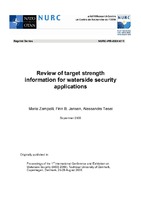| dc.contributor.author | Zampolli, Mario | |
| dc.contributor.author | Jensen, Finn B. | |
| dc.contributor.author | Tesei, Alessandra | |
| dc.date.accessioned | 2018-10-11T14:09:36Z | |
| dc.date.available | 2018-10-11T14:09:36Z | |
| dc.date.issued | 2008 | |
| dc.identifier | 30228 | |
| dc.identifier.govdoc | NURC-PR-2008-011 | |
| dc.identifier.uri | http://hdl.handle.net/20.500.12489/639 | |
| dc.description.abstract | Estimates of the target strength of objects, such as for example scuba tanks and swimmer delivery vehicles, are parameters of interest in all phases of the design of waterside security systems. Results of numerical target strength computations are presented for a variety of simple cylindrical objects, which can be used as fac-simile targets in the design of harbor protection sonars. The discussion covers the structural resonance-dominated and material dependant low-frequency regime, where the acoustic wavelength is of the same order as a characteristic size of the target, as well as the high frequency regime, which is of interest to imaging-sonar applications. Monostatic and bistatic scattering geometries are considered. The numerical results obtained with a validated numerical model are compared to simple engineering approximations for perfectly rigid spheres and finite cylinders. This makes it possible to verify the numerical model results and to establish the regions of validity of the simple engineering approximations for practical applications. | |
| dc.format | 8 p. : ill. (digital, PDF file) | |
| dc.language | English | |
| dc.publisher | NURC | |
| dc.subject | Target strength | |
| dc.subject | Target scattering | |
| dc.subject | Port and harbour protection | |
| dc.subject | Divers, protection from | |
| dc.subject | Sonar | |
| dc.subject | Swimmer Delivery Vehicles (SDV) | |
| dc.title | Review of target strength information for waterside security applications | |
| dc.type | Reprint (PR) | |
| dc.type | Papers and Articles | |
